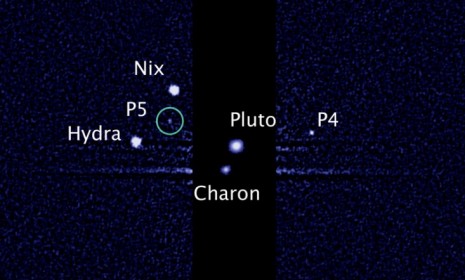Do Pluto and its largest moon form a 'double planet'?
The mysterious dwarf continues to surprise scientists, as a newly discovered moon resurrects a debate over the former planet's status

In 2006, Pluto lost its status as a full-fledged planet and was controversially reclassified as a "dwarf planet," causing more than a few flustered high school science teachers across the country to reach for the Advil. But Pluto's new designation hardly ended the debate. Just last week, a newly discovered moon was spotted hovering in Pluto's orbit, giving the celestial body at least five moons on record. And that got space junkies thinking: With a multitude of hard-to-categorize rocky satellites flying around Pluto, is it possible the 1,421-mile-long world and one of its moons are actually both planets? Here's what you should know:
Remind me again: Why isn't Pluto considered a planet?
The little icy rock at the edge of our solar system was stripped of its planet-hood in 2006 when an international body of scientists decided to redefine what a full-fledged planet is. The new definition stipulates that a planet must orbit the sun, be large enough to "become round due to the force of its own gravity," and "dominate its neighborhood," says National Geographic. But Pluto is hardly the neighborhood bully — it's largest moon, Charon, is roughly half its size. That's why Pluto got demoted.
The Week
Escape your echo chamber. Get the facts behind the news, plus analysis from multiple perspectives.

Sign up for The Week's Free Newsletters
From our morning news briefing to a weekly Good News Newsletter, get the best of The Week delivered directly to your inbox.
From our morning news briefing to a weekly Good News Newsletter, get the best of The Week delivered directly to your inbox.
And what have astronomers discovered now?
Encircling the "lonely little world" is a tiny, irregularly shaped satellite estimated to be just 6 to 15 miles across, says Jeffrey Kluger at TIME. That gives Pluto a grand total of five lunar bodies — "four more than Earth" and "five more than moonless Mercury and Venus." Just last year, a 21-mile "flyspeck of a satellite" smaller than many cities was found, joining Charon and two other tiny moons found in 2005: 42-mile Nix and its big sister, 52-mile Hydra. "Every time we look harder, we find new stuff," Alan Stern, a scientist at the Southwest Research Institute in Boulder, Colo. where the new moon was spotted, tells the Christian Science Monitor.
So... why would Pluto be a "double planet"?
Consider all the tiny moons in the area, and you'll see that Pluto's largest moon, Charon, may actually be a planet itself, says Ray Villard at Discovery. The four baby satellites don't orbit Pluto itself; rather, they circle a center of gravity located between Pluto and Charon, which pivot around one another "like a waltzing pair of ice skaters around a center of mass." Some think this unique relationship classifies Pluto-Charon as a "binary planet."
A free daily email with the biggest news stories of the day – and the best features from TheWeek.com
Are there other double planets?
Not that we know of. But stars are often binary; in fact, binary systems comprise "at least half of the stars in our galaxy," says Discovery's Villard, and dozens of binary asteroids have been documented since 1993. So why not have double planets, too?
Sources: The Atlantic, The Christian Science Monitor, Discovery, National Geographic, TIME
-
 ‘The menu’s other highlights smack of the surreal’
‘The menu’s other highlights smack of the surreal’Instant Opinion Opinion, comment and editorials of the day
-
 Education: More Americans say college isn’t worth it
Education: More Americans say college isn’t worth itfeature College is costly and job prospects are vanishing
-
 One great cookbook: ‘More Than Cake’
One great cookbook: ‘More Than Cake’the week recommends The power of pastry brought to inspired life